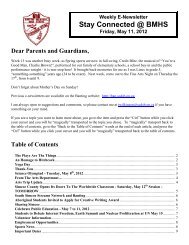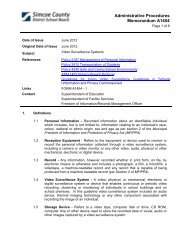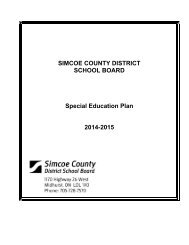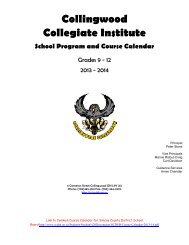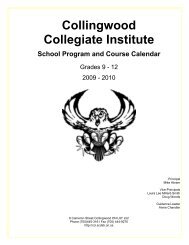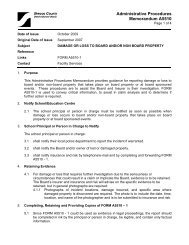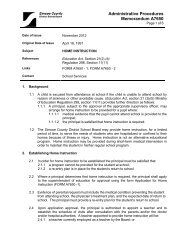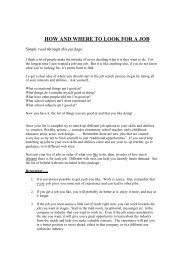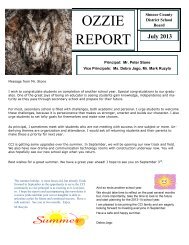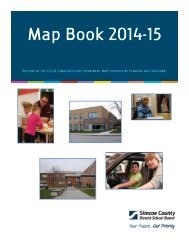Elementary to Secondary Transition - Simcoe County District School ...
Elementary to Secondary Transition - Simcoe County District School ...
Elementary to Secondary Transition - Simcoe County District School ...
- No tags were found...
You also want an ePaper? Increase the reach of your titles
YUMPU automatically turns print PDFs into web optimized ePapers that Google loves.
TEGRITYSTUDENTCOLLABORATIONSPECT LEADERSHIPDRIVENSERVICESCOMPASSIONTHE RIGHTOF ALLSTUDENTSTO BE INCLUDEDTEGRITY COLLABORATIONPlanning“<strong>Elementary</strong> <strong>to</strong><strong>Secondary</strong> <strong>School</strong>”<strong>Transition</strong>sLEADERSHIPA Guide for Parents and Educa<strong>to</strong>rs
Planning “<strong>Elementary</strong> <strong>to</strong> <strong>Secondary</strong>” <strong>Transition</strong>sfor Students with Special Education Needs:A Guide for Parent/Guardian(s) and Educa<strong>to</strong>rs“ELEMENTARY TO SECONDARY”TRANSITIONS"The problem isn’t finding out where you are gonna go – it’s figuring outwhat you are gonna do once you get there that is!"- Mandy Moore (A Walk <strong>to</strong> Remember)Page 1 of 24
Planning “<strong>Elementary</strong> <strong>to</strong> <strong>Secondary</strong>” <strong>Transition</strong>sfor Students with Special Education Needs:A Guide for Parent/Guardian(s) and Educa<strong>to</strong>rsThe mission of the <strong>Simcoe</strong> <strong>County</strong> <strong>District</strong> <strong>School</strong> Board (SCDSB),serving diverse, growing urban and rural communities in the Huroniaand Georgian Bay region, is <strong>to</strong> ensure students reach their full potential<strong>to</strong> become responsible and contributing members of an ever-changingglobal society through quality programs which develop the skills oflifelong learning in a safe, caring environment enhanced by communitysupport.Source: S.C.D.S.B. Mission StatementUnityBy Cleo V. SwaratOriginal poem found in "Thoughts in Poetry" self-published in 1948I dreamed I s<strong>to</strong>od in a studioAnd watched two sculp<strong>to</strong>rs there,The clay they used was a young child’s mindAnd they fashioned it with care.One was a teacher:the <strong>to</strong>ols she used were books and music and art;One was a parentWith a guiding hand and gentle loving heart.And when at last their work was done,They were proud of what they had wrought.For the things they had worked in<strong>to</strong> the childCould never be sold or bought!And each agreed she would have failedif she had worked alone.For behind the parent s<strong>to</strong>od the school,and behind the teacher s<strong>to</strong>od the home!Page 2 of 24
Planning “<strong>Elementary</strong> <strong>to</strong> <strong>Secondary</strong>” <strong>Transition</strong>sfor Students with Special Education Needs:A Guide for Parent/Guardian(s) and Educa<strong>to</strong>rs“<strong>Transition</strong> planning is necessarily a collaborative activity, involving theteam of people who will provide support in assisting the student <strong>to</strong>achieve his or her goals.”<strong>Transition</strong> Planning: A Resource Guide, 2002<strong>Transition</strong> Team<strong>Transition</strong> team members may include:• Parent/Guardian(s)• Student, if deemed appropriate• Principal, or designate• Classroom Teacher(s)• Special Education Resource Teacher• Community agencies• Receiving school’s: Special Education Resource Teacher, GuidanceCounsellor, Student Success Teacher• Board support staffRoles and ResponsibilitiesSpecial Education Advisory Committee (SEAC)• members of SEAC link parent/guardian(s) <strong>to</strong> information aboutprograms and services related <strong>to</strong> specific areas of exceptionality.• information about SCDSB’s SEAC can be found on the board’s publicwebsite at www.scdsb.on.caThe <strong>Simcoe</strong> <strong>County</strong> <strong>District</strong> <strong>School</strong> Board (SCDSB):• supports the transition planning process in all schools• provides professional development opportunities <strong>to</strong> staff regardingexisting support agencies, employment supports and post-secondarysupports• establishes and maintains connections with local and regionalcommunity agenciesThe <strong>School</strong> Principal• follows regulation 181/98 which designates that the Principal isresponsible for ensuring that IEP transition plans are developed andmaintained in accordance with the regulation (see page 7 for details).Page 5 of 24
Planning “<strong>Elementary</strong> <strong>to</strong> <strong>Secondary</strong>” <strong>Transition</strong>sfor Students with Special Education Needs:A Guide for Parent/Guardian(s) and Educa<strong>to</strong>rsDocumentationFor the SCDSB, 3 documents are used in order <strong>to</strong> plan for transitions:1. Individual Education Plan (IEP)2. Planning a <strong>Transition</strong> Strengths and Needs Committee (SNC)meeting record3. IEP <strong>Transition</strong> PlanThe Individual Education Plan (IEP)The IEP is a written plan describing the special education programand/or services required by a student, based on a thorough assessmen<strong>to</strong>f the student’s strengths and needs. An IEP is developed for everystudent identified as exceptional by an Identification, Placement andReview Committee (IPRC). In addition, an IEP may be developed for astudent who has not been formally identified as exceptional but whorequires a special education program and/or services. Additionalinformation about IEPs can be found on the SCDSB public website:www.scdsb.on.ca or on the Ministry of Education’s website:www.edu.gov.on.ca.Planning a <strong>Transition</strong> SNC meeting recordThe Planning a <strong>Transition</strong> SNC meeting record documents the discussionfrom a transition team meeting. This record is used <strong>to</strong> plan Big T andLittle “t” transitions. The document provides school teams withsuggested <strong>to</strong>pics and areas <strong>to</strong> guide the discussion. As well, it provides asection <strong>to</strong> outline the plan of action, responsibilities, and next steps. Atthe end of the meeting, a next meeting date should be set <strong>to</strong> review theplan and discuss what has been working and what needs <strong>to</strong> be changed.Parent/guardian(s) are integral members of this process and theinformation they bring <strong>to</strong> the table should be documented using thismeeting record. This record will be housed in the student’s OntarioStudent Record (OSR). Parent/guardian(s) can request a copy of theminutes.IEP <strong>Transition</strong> PlanFor students with exceptional learning needs who have an IEP, there is asection entitled “<strong>Transition</strong> Plan” in the IEP. The Ministry of Educationrequires the IEP of all exceptional pupils, age 14 or older, <strong>to</strong> include atransition plan (the exception <strong>to</strong> this is students who are identified asGifted). It is specific <strong>to</strong> the Big “T” transition of graduating secondaryschool and entering post-secondary activities, whether it is in<strong>to</strong>Page 7 of 24
Planning “<strong>Elementary</strong> <strong>to</strong> <strong>Secondary</strong>” <strong>Transition</strong>sfor Students with Special Education Needs:A Guide for Parent/Guardian(s) and Educa<strong>to</strong>rsuniversity, college, world of work or the community. The plan outlinespost-secondary goals for the student and serves <strong>to</strong> coordinate theactivities of different individuals and agencies <strong>to</strong> support the studentthrough the transition process. It specifies realistic goals, outlines theactions <strong>to</strong> be taken, identifies who is responsible for the actions andindicates the approximate timelines for these actions. The approach <strong>to</strong>planning is student-centred with attention <strong>to</strong> the Ontario Curriculum orany specific pathway tailored <strong>to</strong> the students’ needs and goals. This planis reviewed at least once per year and updated. Parent/guardian(s) inputin<strong>to</strong> the creation of this document is extremely valuable in order <strong>to</strong>develop a comprehensive plan.Page 8 of 24
Planning “<strong>Elementary</strong> <strong>to</strong> <strong>Secondary</strong>” <strong>Transition</strong>sfor Students with Special Education Needs:A Guide for Parent/Guardian(s) and Educa<strong>to</strong>rs<strong>Elementary</strong> <strong>to</strong> <strong>Secondary</strong> <strong>Transition</strong>Adolescence is a period of change in a young person’s life in terms ofsocial, emotional and physical development. These changes can becumbersome on both the individual and parent/guardian(s). Movingfrom an elementary school <strong>to</strong> a secondary school setting can add <strong>to</strong> thisstress. Developing a comprehensive and integrated transition plan forstudents can ease anxiety and decrease stress for both the student andparent/guardian(s).Students should be well prepared for entry in<strong>to</strong> grade nine. Planning forthe transition from elementary <strong>to</strong> secondary school should ideally beginduring the student’s grade 7 school year or at least, in September ofhis/her grade 8 school year. Parent/guardian(s) and school staff fromboth the elementary school and the high school should work <strong>to</strong>gether <strong>to</strong>develop transition plan <strong>to</strong> support the student with their entry <strong>to</strong> highschool.In order <strong>to</strong> begin the transition process, elementary schools will plan andhost a “Planning a <strong>Transition</strong>” SNC with the purpose of outlining atimeline for the student’s transition <strong>to</strong> secondary school. All registrationinformation for secondary schools will be sent home with the studentalong with course options sheets over the course of the student’s grade 8school year.Tips for the transition:• Planning ahead helps with a smooth transition <strong>to</strong> the school system.• It is suggested that you start discussing this process early in theyear with your son/daughter <strong>to</strong> help provide lots of time forplanning.• Your school contact, family support worker, or a friend may help youand accompany you <strong>to</strong> meetings.• Rehearse the travel route <strong>to</strong> the high school.• Depending on your child’s ability level, consider pre-teaching anyskills that may be required in the new school setting (e.g. using alock for a locker), where <strong>to</strong> go for help, and moving aroundindependently (changes such as moving from classroom <strong>to</strong>classroom for each period should be explained and taught <strong>to</strong> thechild).• Thought should be given <strong>to</strong> the new daily school routines (contactyour child’s school for specific details).Page 9 of 24
Planning “<strong>Elementary</strong> <strong>to</strong> <strong>Secondary</strong>” <strong>Transition</strong>sfor Students with Special Education Needs:A Guide for Parent/Guardian(s) and Educa<strong>to</strong>rsQuestions <strong>to</strong> consider prior <strong>to</strong> the transition:• What are my wishes, goals and expectations for my son/daughter?• What are my son/daughter(s) strengths and needs?• What does my son/daughter enjoy doing?• How does my son/daughter communicate his/her needs, wishes andinterests?• How does my son/daughter interact with other students?• How does my son/daughter learn?• What strategies have proven <strong>to</strong> be most effective for myson/daughter?• Are there recent assessments and/or reports about myson/daughter that I want <strong>to</strong> share?Possible action items <strong>to</strong> develop a comprehensive transition plan:• Attend a “Planning a <strong>Transition</strong> SNC” <strong>to</strong> be held at the receivingschool in which you can discuss your child’s strengths and needsand clarify roles and responsibilities for yourself, school staff andany others involved.• Consider providing the school Principal with a portfolio that includescurrent assessments, samples of your son/daughter’s work,elementary school reports, and a description of strategies used athome. Consider adding any goals that you may have for your child’sfuture after secondary school. This will assist the school staff indesigning a program that will best meet your child’s needs, whilebuilding upon their strengths.Selecting a Graduation PathwayStudents graduate with one of the following:• Ontario <strong>Secondary</strong> <strong>School</strong> Diploma (OSSD)• Ontario <strong>Secondary</strong> <strong>School</strong> Certificate (OSSC)• Certificate of Accomplishment (COA)Requirements for an Ontario <strong>Secondary</strong> <strong>School</strong> Diploma (OSSD)In order <strong>to</strong> earn an OSSD a student must:• earn 30 credits (18 compulsory and 12 optional credits);• complete 40 hours of community involvement activities;• complete the provincial literacy graduation requirement (OSSLT)Page 10 of 24
Planning “<strong>Elementary</strong> <strong>to</strong> <strong>Secondary</strong>” <strong>Transition</strong>sfor Students with Special Education Needs:A Guide for Parent/Guardian(s) and Educa<strong>to</strong>rsSource: Ministry of Education, www.edu.gov.on.caPage 11 of 24
Planning “<strong>Elementary</strong> <strong>to</strong> <strong>Secondary</strong>” <strong>Transition</strong>sfor Students with Special Education Needs:A Guide for Parent/Guardian(s) and Educa<strong>to</strong>rsRequirements for an Ontario <strong>Secondary</strong> <strong>School</strong> Certificate (OSSC)The Ontario <strong>Secondary</strong> <strong>School</strong> Certificate will be granted on request <strong>to</strong>students who leave school before earning the Ontario <strong>Secondary</strong> <strong>School</strong>Diploma and who have earned a minimum of 14 credits, seven of whichsatisfy the compulsory credit requirements.Compulsory Credits Optional Credits(<strong>to</strong>tal of seven) (<strong>to</strong>tal of seven)two credits in English seven credits selected bythe student fromavailable coursesone credit inCanadian geographyOR his<strong>to</strong>ryone credit inmathematicsone credit in scienceone credit in healthand physicaleducationone credit in the artsor technologicaleducationNote: Students are not required <strong>to</strong> complete Community InvolvementHours or pass the OSSLT.Requirements for an Ontario <strong>Secondary</strong> <strong>School</strong> Certificate ofAccomplishmentStudents who leave school before fulfilling the requirements for theOntario <strong>Secondary</strong> <strong>School</strong> Diploma or the Ontario <strong>Secondary</strong> <strong>School</strong>Certificate may be granted a Certificate of Accomplishment. Thiscertificate may be a useful means of recognizing achievement forstudents who plan <strong>to</strong> take certain vocational programs or other kinds offurther training. Students who return <strong>to</strong> school <strong>to</strong> complete additionalcredit and non-credit courses will have their transcript updated, but willnot be issued a new Certificate of Accomplishment.Page 12 of 24
Planning “<strong>Elementary</strong> <strong>to</strong> <strong>Secondary</strong>” <strong>Transition</strong>sfor Students with Special Education Needs:A Guide for Parent/Guardian(s) and Educa<strong>to</strong>rsSelecting a Course PathwayDefinition of a CreditA credit is granted in recognition of the successful completion of a coursethat has been scheduled for a minimum of 110 hours. A half credit maybe granted for each 55-hour part of a 110-hour ministry developedcourse. Credits are granted <strong>to</strong> students by the principal of a secondaryschool on behalf of the Minister of Education.Types of CoursesFour types of courses are offered in Grade 9 and 10:• Academic courses taken throughout secondary school can lead <strong>to</strong>university/college and university courses in senior grades• Applied courses taken throughout secondary school can lead <strong>to</strong>college and workplace courses• Locally Developed courses may be offered for students who areworking below grade level. These courses are intended <strong>to</strong> enablestudents <strong>to</strong> gain the necessary skills required <strong>to</strong> be successful inapplied and workplace level courses. Locally developed courses arecourses that meet educational needs not met by provincialcurriculum policy documents. Students who need additionalsupport in academic core subjects (English, mathematics, scienceand his<strong>to</strong>ry) may count up <strong>to</strong> 6 Locally Developed courses ascompulsory courses in grades 9 and 10.• Open courses are designed <strong>to</strong> prepare students for further study incertain subjects and <strong>to</strong> enrich their education generally.• Students can choose <strong>to</strong> take courses from different types.In Grade 11 and 12, courses are offered <strong>to</strong> prepare students for theirpostsecondary destinations:• University preparation courses are designed <strong>to</strong> equip students withthe knowledge and skills they need for entrance <strong>to</strong> university.• University/College preparation courses are designed <strong>to</strong> equipstudents for entrance <strong>to</strong> university and college programs.• College preparation courses prepare students for college programsand related careers. Many apprenticeships require College levelcourses as a minimum.Page 13 of 24
Planning “<strong>Elementary</strong> <strong>to</strong> <strong>Secondary</strong>” <strong>Transition</strong>sfor Students with Special Education Needs:A Guide for Parent/Guardian(s) and Educa<strong>to</strong>rs• Workplace courses prepare students for direct entry in<strong>to</strong> theworkplace or admission <strong>to</strong> some apprenticeship programs andother training programs.• Open courses are appropriate for all students and are not linked <strong>to</strong>any specific postsecondary destination.Substitutions for Compulsory CoursesTo meet individual student’s needs, principals may replace up <strong>to</strong> threecompulsory courses (or the equivalent in half courses). Each substitutionwill be noted on the student’s Ontario Student Transcript.Role of Student Success TeachersThe <strong>Secondary</strong> Student Success Teacher has many roles within a schoolthat may include the following: track the progress of students at risk ofnot graduating; support school-wide efforts <strong>to</strong> improve outcomes forstudents struggling with the secondary curriculum; re-engage earlyschool leavers; provide direct support/instruction <strong>to</strong> these students inorder <strong>to</strong> improve student achievement, retention, and transitions.Working <strong>to</strong>gether with Guidance and Special Education staff, theStudent Success Teacher is an essential part of an integrated service andteam approach <strong>to</strong> support students at risk through links <strong>to</strong> in-school,board, community and other resources. These teachers also establishcommunication strategies with schools in the area and the identificationof incoming at-risk students.<strong>Transition</strong> CalendarThe <strong>Simcoe</strong> <strong>County</strong> <strong>District</strong> <strong>School</strong> Board has developed a possibletimeline for <strong>Elementary</strong> <strong>to</strong> <strong>Secondary</strong> <strong>School</strong> transitions. This timelinehas been shared with school staff. Please note: the timeline will beindividualized for each student.Page 14 of 24
Planning “<strong>Elementary</strong> <strong>to</strong> <strong>Secondary</strong>” <strong>Transition</strong>sfor Students with Special Education Needs:A Guide for Parent/Guardian(s) and Educa<strong>to</strong>rs<strong>Transition</strong> Steps Month PersonsInvolvedo Identify a transition planning teamNovembero Discuss transition planning with family andstudent during an SNCo Identify an individualized timeline and settarget dateso Grade 8 students visit the home secondaryschoolo Gather information about the secondaryschoolo Share information gathered from “PlanningA <strong>Transition</strong>” SNC with the secondaryspecial education departmen<strong>to</strong> Grade 8 teachers complete online transitionprofile for special education students.o <strong>Secondary</strong> SERT <strong>to</strong> visit the <strong>Elementary</strong>school <strong>to</strong> assist with option sheetsDecemberJanuaryo <strong>Elementary</strong>school teamo Parent /Guardian(s)o Studen<strong>to</strong> <strong>Elementary</strong>SERT andRCTo <strong>Secondary</strong>SERTo SERT andRCTo SERTo <strong>Secondary</strong>SpecialEducationLeado StudentDocumentationo SNC withaction ofsetting“Planning a<strong>Transition</strong>”SNC dateo “Planning a<strong>Transition</strong>”SNCo “Planning a<strong>Transition</strong>”SNCo Order form forbinderPersonsResponsibleo <strong>Elementary</strong>Principalo <strong>Elementary</strong>SERTo <strong>Elementary</strong>school team<strong>to</strong> contact<strong>Secondary</strong>SpecialEducationdepartment<strong>to</strong> inform ofspecialeducationneedstransitionso <strong>Secondary</strong>SERTo <strong>Elementary</strong>SERTPage 15 of 24
Planning “<strong>Elementary</strong> <strong>to</strong> <strong>Secondary</strong>” <strong>Transition</strong>sfor Students with Special Education Needs:A Guide for Parent/Guardian(s) and Educa<strong>to</strong>rs<strong>Transition</strong> Steps Month PersonsInvolvedo <strong>Transition</strong> planning meeting with parents, Februaryo <strong>Secondary</strong>student, <strong>Elementary</strong> and <strong>Secondary</strong> schoolschool teamteams for a “Planning a <strong>Transition</strong>” SNCo Studen<strong>to</strong> Share current IEP, most recent report cardand IEP <strong>Transition</strong> Plan with <strong>Secondary</strong><strong>School</strong>o Order an Orientation or <strong>Transition</strong> Binder forthe student from special education coach, ifappropriateo Students with special education needs visitthe secondary school for a half day(including lunch) <strong>to</strong> learn more about homesecondary school with elementary SERTo <strong>Secondary</strong> SERT meets with outside Aprilo <strong>Secondary</strong>agencies regarding specific studentso IPRC’s held for <strong>Elementary</strong> <strong>to</strong> <strong>Secondary</strong><strong>Transition</strong>s, if applicableo Make arrangements <strong>to</strong> transfer SEAequipment <strong>to</strong> secondary school bycompleting the form on the staff website(see APM A 8530)April/May* reminderpackages have <strong>to</strong>be <strong>to</strong> theparticipants atleast 10 days prior<strong>to</strong> the IPRC daySERTo <strong>Elementary</strong>and<strong>Secondary</strong><strong>School</strong>Teamso Parent /Guardian(s)o StudentDocumentationo IPRC packageanddocumentationPersonsResponsibleo <strong>Secondary</strong><strong>School</strong>Teamo <strong>Secondary</strong>SERTo <strong>Elementary</strong>& <strong>Secondary</strong>Principal <strong>to</strong>collaborate<strong>to</strong> set datesfor IPRCs &determinelocationo <strong>Elementary</strong>SERTcreatesIPRCpackagesPage 16 of 24
Planning “<strong>Elementary</strong> <strong>to</strong> <strong>Secondary</strong>” <strong>Transition</strong>sfor Students with Special Education Needs:A Guide for Parent/Guardian(s) and Educa<strong>to</strong>rs<strong>Transition</strong> Steps Month PersonsInvolvedo Student <strong>to</strong> visit the secondary school May/Junehe/she will be attending in the Fall (numberof visits are individualized based on studentneed)o Transfer of SEA equipment needs <strong>to</strong> becompleted on-lineo Studen<strong>to</strong> Student may meet with <strong>Secondary</strong> SERTfor a <strong>to</strong>ur of school, make timetablechanges, and review schedule.o <strong>Secondary</strong> SERT <strong>to</strong> locate SEA equipmen<strong>to</strong> <strong>Elementary</strong>and<strong>Secondary</strong>schoolteamsAugust/September o <strong>Secondary</strong>SERTo StudentDocumentationo FollowingAction Planfrom “Planninga <strong>Transition</strong>”SNCPersonsResponsibleo <strong>Elementary</strong>and<strong>Secondary</strong><strong>School</strong>Teamso <strong>Secondary</strong>SERTPage 17 of 24
Planning “<strong>Elementary</strong> <strong>to</strong> <strong>Secondary</strong>” <strong>Transition</strong>sfor Students with Special Education Needs:A Guide for Parent/Guardian(s) and Educa<strong>to</strong>rsLITTLE “t” TRANSITIONS“The journey of a thousand miles begins with a single step.”- Lao TsePage 18 of 24
Planning “<strong>Elementary</strong> <strong>to</strong> <strong>Secondary</strong>” <strong>Transition</strong>sfor Students with Special Education Needs:A Guide for Parent/Guardian(s) and Educa<strong>to</strong>rs“Little t” <strong>Transition</strong>s<strong>Transition</strong>s happen before, during and after the school day. They rangefrom the bus ride <strong>to</strong> school <strong>to</strong> moving between locations in the school(e.g., going from the classroom <strong>to</strong> the library) <strong>to</strong> changing subjects (e.g.,math <strong>to</strong> science) <strong>to</strong> exit routine at the end of the day. While thesetransitions may seem small, they can cause some students with specialeducation needs <strong>to</strong> feel anxious and unsure. All students, but especiallystudents with special education needs, tend <strong>to</strong> perform best when thereis routine and the schedule is predictable.In order <strong>to</strong> assist your child cope with these Little “t” transitions tha<strong>to</strong>ccur throughout their day, you can:• Establish a routine for getting ready for school.• Practise with your child what he/she needs <strong>to</strong> do <strong>to</strong> get ready at theend of the school day (e.g., packing their bag).• Ask the teacher for an outline of the course or a monthly schedule ofthe activities the class will be participating in and reviewing theschedule with your child on a regular basis.• Share with the school team successful strategies you use at home <strong>to</strong>prepare your child for transitions.• Attend a “Planning a <strong>Transition</strong> SNC.” If your child is strugglingwith Little “t” transitions at school, your school team may requestyour attendance at a “Planning a <strong>Transition</strong>s SNC.” Your input isinvaluable <strong>to</strong> assist the school team in continuing <strong>to</strong> provide yourchild with a program <strong>to</strong> best meet his/her needs.Page 19 of 24
Planning “<strong>Elementary</strong> <strong>to</strong> <strong>Secondary</strong>” <strong>Transition</strong>sfor Students with Special Education Needs:A Guide for Parent/Guardian(s) and Educa<strong>to</strong>rsCommunity Resources211 – Community ConnectionAlternate: 1-866-743-7818TTY: 1-888-435-6086Candelighters <strong>Simcoe</strong>6 Emily CourtBarrie, ONL4N 6B4(705) 737-4296Catulpa Community Support Services165 Ferris LaneBarrie, ONL4M 2Y1(705) 733-3227Central Community Care Access CentreRichmond Hill Office1100 Gorham Street Unit 1Newmarket, ON905 763 9928www.ccac-ont.caChildren’s Treatment Network165 Ferris LaneBarrie, ONL4M 2Y1(705) 719-4795Community Living Huronia339 Olive StreetMidland, ONL4R 2R4(705) 526-4253 ex. 170Deaf Access <strong>Simcoe</strong>340-80 Bradford St.Barrie, ONL4N 6S7(705) 728-3577Page 20 of 24
E3 Community Services250-A Peel StreetCollingwood, ONL9Y 3W2(705) 446-0816Planning “<strong>Elementary</strong> <strong>to</strong> <strong>Secondary</strong>” <strong>Transition</strong>sfor Students with Special Education Needs:A Guide for Parent/Guardian(s) and Educa<strong>to</strong>rsGeneva Centre for Autism112 Mer<strong>to</strong>n StreetToron<strong>to</strong>, ONM4S 2Z8(416) 322-7877Integration Action for Inclusion OntarioLocal ChapterMary Madaleno1911 Moons<strong>to</strong>ne Rd. WestElmvale, ONL0L 1P0705-322-1648Kinark Child and Family Services34 <strong>Simcoe</strong> StreetBarrie, ONL4N 6T4(705) 726-8861Learning Disabilities Association of <strong>Simcoe</strong> <strong>County</strong>76 Mulcaster Street, Second FloorBarrie, ONL4M 3M4(705) 726-5553 or 1-866-919-5372Ontario Early Years Centre - Barrie72 Ross Street, Unit #11Barrie, ONL4M 3M4(705) 792-7878Ontario Early Years Centre – Allis<strong>to</strong>n13 Welling<strong>to</strong>n Street WestAllis<strong>to</strong>n, OntarioL9R 1J3(705) 435-4308Page 21 of 24
Planning “<strong>Elementary</strong> <strong>to</strong> <strong>Secondary</strong>” <strong>Transition</strong>sfor Students with Special Education Needs:A Guide for Parent/Guardian(s) and Educa<strong>to</strong>rsOntario Early Years Centre - Orillia80 Colborne StreetOrillia, OntarioL3V 2Y7(705) 325-1299Ontario Early Years Centre - Collingwood250-A Peel StreetCollingwood, OntarioL9Y 3W2(705) 446-0816Ontario Early Years Centre – Midland356 King StreetMidland, OntarioL4R 3M8(705) 526-9820<strong>Simcoe</strong> Community Services39 Fraser CourtBarrie, ONL4N 5J5(705) 726-9082<strong>Simcoe</strong> Muskoka Community Care Access Centre15 Sperling DriveBarrie, ONL4M 6K9(705) 721-8010Page 22 of 24
Planning “<strong>Elementary</strong> <strong>to</strong> <strong>Secondary</strong>” <strong>Transition</strong>sfor Students with Special Education Needs:A Guide for Parent/Guardian(s) and Educa<strong>to</strong>rsResourcesAutism Spectrum Disorder (ASD) Resource Guide: A reference for schoolboard staff, 2007, Kinark <strong>School</strong> Support Program and <strong>Simcoe</strong> <strong>County</strong><strong>District</strong> <strong>School</strong> BoardEffective Educational Practices for Students with Autism SpectrumDisorders: A Resource Guide, 2007, Ministry of Education.Employment Guide for Students with Disabilitieshttp://www.edu.gov.on.ca/eng/tcu/students/disabilities/Planning Entry <strong>to</strong> <strong>School</strong>: A Resource Guide, 2005, Ministry ofEducation.Shared Solutions: A Guide <strong>to</strong> Preventing and Resolving ConflictsRegarding Programs and Services for Students with Special EducationNeeds, 2007, Ministry of Education.Steps <strong>to</strong> <strong>School</strong> for Children with Special Needs: A pamphlet forparent/guardian(s), 2009, <strong>Simcoe</strong> <strong>County</strong> <strong>District</strong> <strong>School</strong> Board, <strong>Simcoe</strong>Muskoka Catholic <strong>District</strong> <strong>School</strong> Board, <strong>Simcoe</strong> <strong>County</strong> EarlyIntervention SystemThe Individual Education Plan: A Resource Guide, 2004, Ministry ofEducation.<strong>Transition</strong> Planning: A Resource Guide, 2002, Ministry of Education.<strong>Transition</strong> Planning: Parent Guide for Students with Special EducationNeeds, 2009, <strong>Simcoe</strong> Muskoka Catholic <strong>District</strong> <strong>School</strong> Board.<strong>Transition</strong>s <strong>to</strong> Postsecondary Education: A Resource Guide for Studentswith Disabilitieshttp://www.edu.gov.on.ca/eng/tcu/students/transitions/Page 23 of 24
Glossary of TermsPlanning “<strong>Elementary</strong> <strong>to</strong> <strong>Secondary</strong>” <strong>Transition</strong>sfor Students with Special Education Needs:A Guide for Parent/Guardian(s) and Educa<strong>to</strong>rsABA – Applied Behaviour AnalysisAdmin. - AdministrationAIP – Autism Intervention ProgramASD – Autism Spectrum DisorderCFS – Connections for StudentsCOA – Certificate of AccomplishmentEA – Educational AssistantHRT – Hearing Resource TeacherIBI – Intensive Behaviour InterventionIEP – Individual Education PlanK-TEA - Kaufman Test of Educational AchievementMCYS – Ministry of Child and Youth ServicesOSR – Ontario Student RecordOSSC – Ontario <strong>Secondary</strong> <strong>School</strong> CertificateOSSD – Ontario <strong>Secondary</strong> <strong>School</strong> DiplomaOSSLT – Ontario <strong>Secondary</strong> <strong>School</strong> Literacy TestRCT – Regular Classroom TeacherSEAC – Special Education Advisory CouncilSERT – Special Education Resource TeacherSCDSB – <strong>Simcoe</strong> <strong>County</strong> <strong>District</strong> <strong>School</strong> BoardSLP – Speech and Language PathologistSpec. Ed. – Special EducationSNC – Strengths and Needs CommitteeSSP – <strong>School</strong> Support ProgramVRT – Vision Resource TeacherPage 24 of 24



